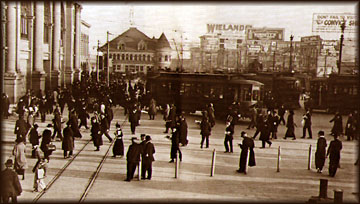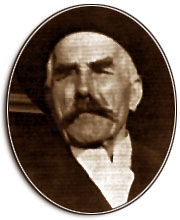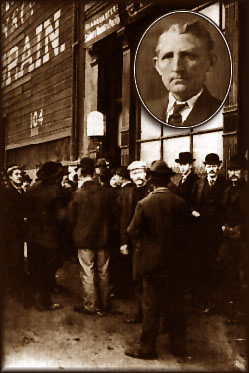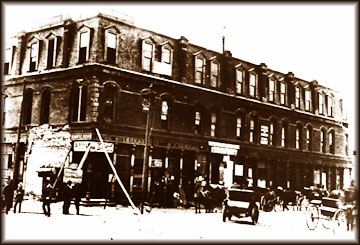|
Urban Development AUDIFFRED BUILDING, SAN FRANCISCO |
|
|
Urban histories are formed by interpreting sources, studying memorabilia, viewing architecture metaphorically, cataloguing myths and facts. The process is retrospective and, occasionally, voyeuristic. Structure is never mute. The course of restoration reveals lost pasts. Heroes and values are identified and help contemporary society define itself. These are some stories and myths relating to San Francisco's impressive Audiffred Building. The site was resold to G. Male' and Hippolite d'Audiffred in December 1873. At the age of twenty in 1850, Audiffred had left France for Vera Cruz, Mexico, presumably to seek his fortune. Twelve years later, France invaded Mexico in support of a reactionary coup aimed at overthrowing a liberal regime. Shortly thereafter, the French installed an Austrian archduke as head of state. Maximilian, Emperor of Mexico, proved unusually incompetent by managing to alienate both his supporters and enemies. When the French army vacated Mexico in 1867, he stayed to fight on. Capture and execution followed. Needless to say, Audiffred found being French in Vera Cruz more than a little awkward. Exercising common sense and demonstrating a strong instinct for survival, he bought a donkey, loaded it with belongings and walked 2,500 miles to San Francisco.  There is no recorded evidence that Audiffred commissioned an architect. It seems likely that a profile of the building was developed by a draftsman, deriving the design from sketches of Parisian commercial buildings of the 18th and 19th centuries. The Mansard Roof, housing a garret with tall, round-topped windows and decorated with heavy brick crenellation, is a feature that can still be seen all over Paris today. The building was completed in 1889 at a time when San Francisco had become the busiest waterfront on the West Coast. The Embarcadero's docks and pier were crowded with square-rigged trading ships from all parts of the world. Initial tenants of the Audiffred Building included a bar called the Bulkhead Saloon and Coffee Parlour, as well as the headquarters of the Coast Seamen's Union. Waterfront industrial relations were contentious in America during the last decades of the 19th century. Ship owners had little regard for the welfare or rights of the sailors and seamen who made commercial trade possible. Many attempts to organise seamen had either stalled or had been put down by force.  In 1901, when ship owners conspired to attempt to destroy the Coast Seamen's Union, Furenseth marshalled his forces along the West Coast from his office in the Audiffred Building. Leading the union in a long and bloody strike, he eventually broke the ship owners. Strike action had for the first time resulted in a modicum of workplace rights being established, protecting merchant sailors from inhumane working conditions. The basis of Furenseth's resolve is clearly stated in his simple poem: You can put me in jail but you cannot give me narrower quarters than as a seaman I have always had. You cannot give me coarser food than I have always eaten. You cannot make me lonelier than I have always been. The Great Earthquake of 1906 marked a turning point in the development of San Francisco. Almost 70% of the town was destroyed over a four-day period. Much of San Francisco's waterfront was reduced to ruins. However, period photographs show an unlikely Audiffred Building standing alone in a Hiroshima-like landscape. According to local legend, the publican in the building intercepted firefighters who were attempting to halt fires by dynamiting waterfront structures. A deal was struck, and firemen fought the flames for three days while consuming a firehose cart full of wine, as well as two-quarts of whiskey per man. Hippolite d'Audiffred's grandson, Henri, recalled the scene: "Gripping my hand, he walked me through the smoking ruins and suddenly spied our building… only a few bricks were missing. He gasped and said, 'Well, I'll be a sad son of a bitch!'"  San Francisco had prospered after World War I but was not immune to worldwide depression following the New York stock market crash of 1929. During the 1930s, waterfront relations between labour unions and management deteriorated dramatically. Several unions represented waterfront trades at this time, but coordination between them was poor. Sailors' unions often disagreed with longshore unions as to whose men were responsible for unloading ships, and such scuffles created lifelong enmity between union heads. Maritime businesses took advantage of hard times and labour bickering by launching a systematic union-busting strategy, with longshore workers a central target. At issue was the right to unionise all waterfront workers, as well as the right to control hiring. The longshoremen were organised by Harry Bridges, a former Australian seaman, from an office in the Audiffred Building. In mid 1934, Harry called a strike in San Francisco. Unionists in other industries walked out in support, shutting down virtually every form of commerce in the three western coastal states. The Government of California took decisive action, calling in the National Guard so that, within a short time, San Francisco's waterfront was occupied by 10,000 troops. On July 5, 1934, the strike turned ugly. Armed guardsmen battling rioters killed two longshoremen outside the Audiffred Building. To this day, seagoing unions of San Francisco sponsor an annual commemoration of "Bloody Thursday" outside the building in honour of the murdered strikers. Ultimately the strikers prevailed, setting new standards for waterfront workers throughout the country as well as cementing the power of unions in San Francisco. Harry Bridges went on to form the Industrial Longshoremen's and Warehousemen's Union (ILWU), over which he presided from 1937 to 1977. He led a record-breaking 134-day strike in 1971, and was regularly accused of being a communist—Soviet leader Kruschev once commenting that he was the only person worth visiting in America. In the course of his eventful life, Bridges successfully defended deportation proceedings, won a US Supreme Court decision in support of free speech, and led a crusade against union corruption. He died in 1990 as one of America's most celebrated labour figures. San Francisco's great bridges were built during the late 1930's. The city spilled over them into the North Bay and East Bay. Commerce diversified away from the port and industrial distribution hubs moved to Oakland. Ferries became less important. The end of World War II marked the beginning of a serious decline in San Francisco's waterfront area. The Embarcadero around the Audiffred Building turned into a skid row as the remaining financial centres moved uptown towards Montgomery Street. In 1946, as if to signal the final demise of the old waterfront, the Seven Seas Club became a tenant in the Audiffred. It was a home for homeless sailors. Around this time the Audiffred family sold the property to a doctor and a lawyer. The doctor was Bill Weiner, an obstetrician and gynaecologist. The attorney was Wayne Collin, a civil libertarian who defended Iva Ikuki Toguri D'Aquino, otherwise known as 'Tokyo Rose'. This was the nickname given by U.S. troops in the Pacific to at least a dozen women who broadcast propaganda from Japan during World War II. Iva had been visiting Japan at the outbreak of hostilities, and steadfastly claimed to have acted under duress. In a controversial trial during 1949, she was convicted of treason—the popular desire for retribution clashing with calls to preserve the rights of unpopular minorities. Just as victors write the history, so too they define appropriate levels of justice. Iva was imprisoned until 1956. On January 19, 1977, President Gerald R. Ford finally granted her a pardon. Meanwhile, the Audiffred Building continued to attract colourful and eccentric occupants. In 1948, the San Francisco School of Art underwent a major upheaval that resulted in Hassel Smith, a prominent artist, leaving the school and setting up studios on the third floor of the Audiffred. In the ensuing years, the upper floors of the building became home to many famous West Coast literary and artistic tenants. Among the most notable were Howard Hicks, Soniko Geschtoff, Joan Brown, Herbert Wasserman, Frank Lobdell, Peter Burriskov and Lawrence Ferlinghetti. The artists' studios closed in 1955 when the top two floors of the Audiffred were condemned. The artistic occupants of the Audiffred Building reflected an embryonic and somewhat anarchistic social movement, made up of individuals searching for an alternative to the overwhelming conformity of post-war American society. This desire for change was initially realised in the avant-garde culture of the Beat Generation, and was later manifest in the anti-war and drug cultures of the 1960s. It is paradoxical that while artistic rebels occupied the Audiffred Building, urban planners in San Francisco were laying out their own vision of the new America. The result was a four-storey freeway, built around the Embarcadero during the 1960s. This traffic megalith cut the city off from a waterfront universally recognised as one of the most beautiful and spectacular in the world. By 1969, the Audiffred was boxed in by a freeway and lay in the heart of skid row. Its principal tenant was a saloon called Riordan's—the kind of place where looking sideways at the drinker next to you might earn a fist in the mouth. Other tenants came and went in the remaining ground floor shop fronts. In 1978, a cook working at Dory's Club, a fast-food place, tried to mend some basement plumbing with a welding torch. This set off an explosion in a gas main, which set fire to the building and completely devastated the interior, leaving only a delicate brick facade. The Audiffred Building was condemned and scheduled for demolition. Vital cities are organisms, reconstituting themselves in the face of economic and social change and causing structures to cycle from one existence to another. By 1978, commercial activity in San Francisco had once again spread back toward the waterfront as intensive property speculation fuelled redevelopment and growth. The people of San Francisco rallied around the Audiffred Building and, with encouragement offered by the US Department of the Interior, it was saved. In May 1981, as Landmark No. 7 of the City of San Francisco, it was placed on the National Register of Historic Places. Mayor Dianne Feinstein officiated at the ceremony to mark this occasion on March 16, 1982. Aided by government tax credits, the Audiffred Building's difficult and complex restoration was accomplished over a two-year period. The opening celebration took place on April 18, 1984—the 78th anniversary of the Great Earthquake. A large attendance including new, up-market tenants heard Hippolite d'Audiffred's 90 year-old grandson, Henri, reflect on the days of the old waterfront. "You know," he told them, "the old waterfront really got a bum rap… they said it was full of drunken sailors and whores. Hell, we were too broke to buy booze… and all the whores were uptown with the businessmen who had real dough". The icing on the cake came in 1989, when an earthquake severely damaged the four-storey freeway next to the building, leading to the roadway's eventual demolition. The city got back its waterfront. At the Audiffred Building, only a few bricks were missing. RELATED LINKS Museum of the City of San Francisco Harry Bridges The Beat Generation American Civil Liberties Union Bank of America National Register of Historic Places Labor Activists Maritime Museums
|
||
![]()
Copyright © 2005 Advanced Land Resources. All rights reserved.
This web site conforms to the standards XHTML 1.0 Transitional and CSS2.
